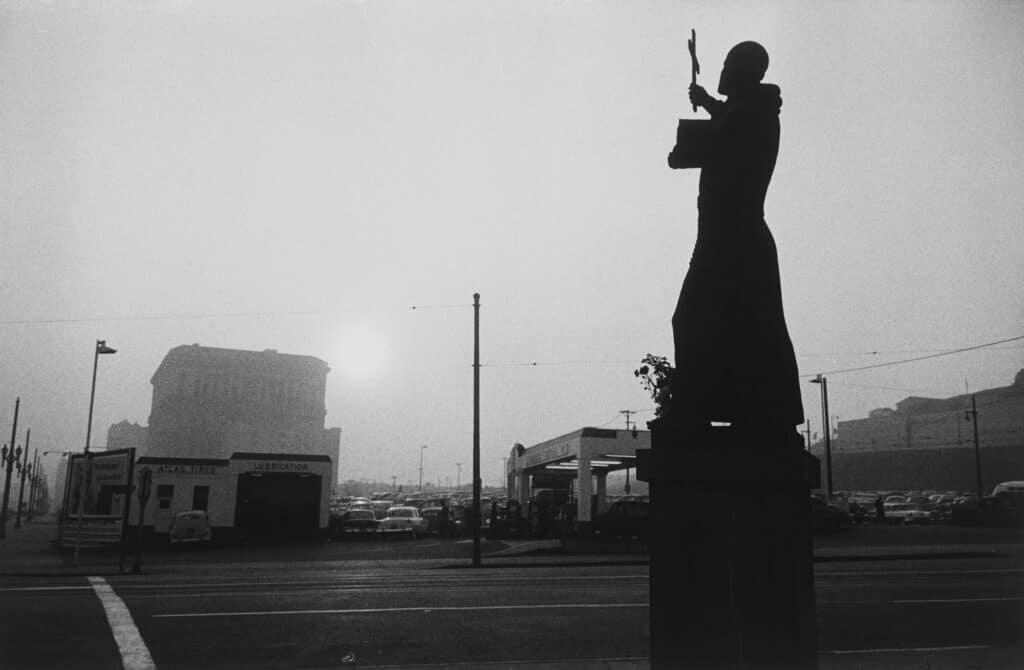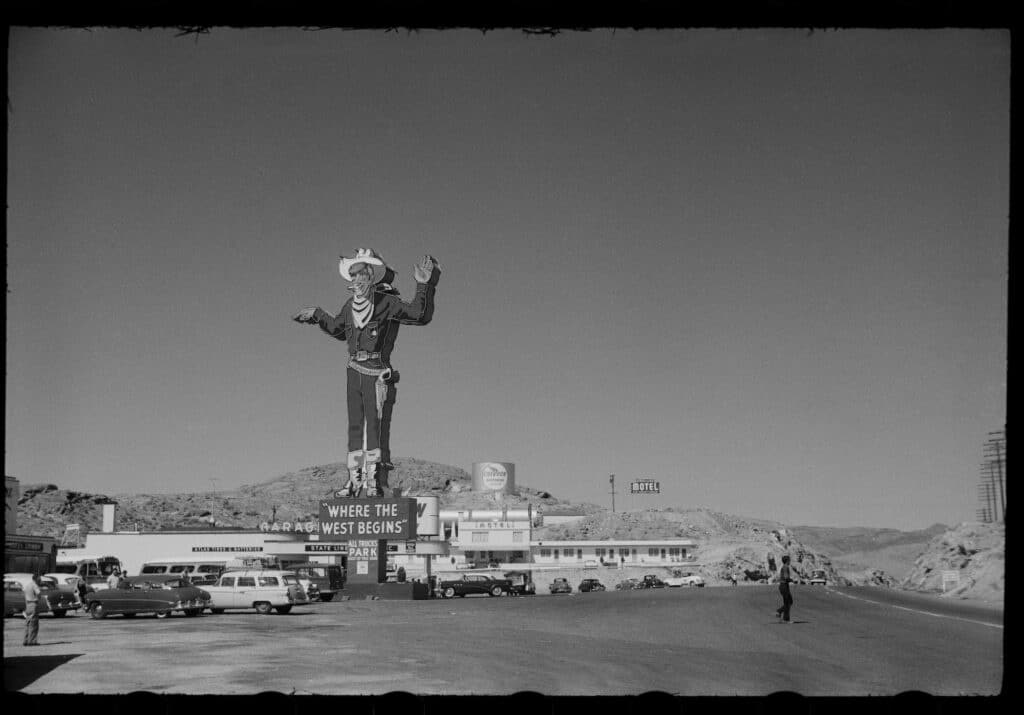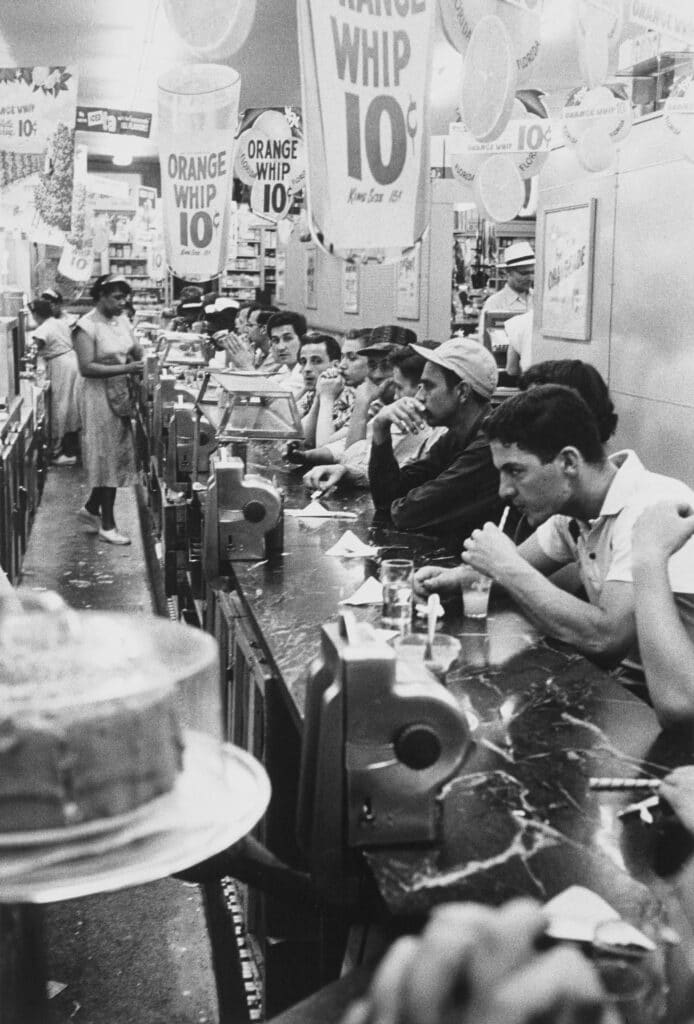Nineteen fifty-five was a year of unbridled optimism in America. The postwar economy was humming; the polio vaccine had finally arrived; car ownership was up (and with it the sense of hit-the-road freedom); both Disneyland and McDonald’s opened, ushering in a new chapter of gung-ho consumerism; and Little Richard recorded his wildly popular “Tutti Frutti,” with its ecstatic “a-wop-bop-a-loo-bop-a-lop-bam-boom!” catchphrase that seemed to land squarely atop the effervescent zeitgeist of American Exceptionalism.
All of which may explain why two photographers, the ink barely dry on their respective Guggenheim Fellowships, set off across America to take the pictorial pulse of the country. One was Robert Frank, who returned from his epic road trip with the 27,000-plus images he then drew from to make his iconic, career-launching book, The Americans. The other was Todd Webb, a deeply gifted if understated photographer, as well as a close friend of Georgia O’Keeffe’s, who … would never become a household name.
Now, 68 years after their momentous crisscrossing of America—and for the first time ever—the photographs made on their respective trips will be seen together in an exhibition that, among other things, documents how spending time in the country’s nooks and crannies (crannies like Lovelock, Nevada, for instance, and Aliquippa, Pennsylvania) dramatically shifted how Frank and Webb came to view both America and Americans.
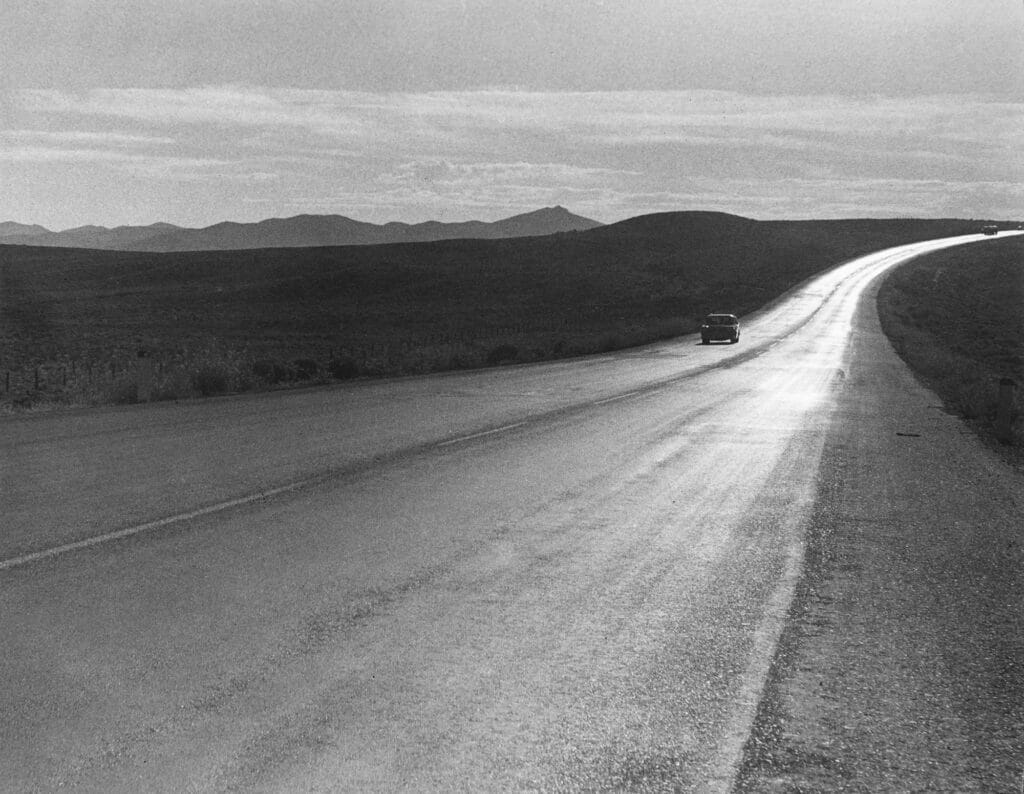
The exhibition, “Robert Frank and Todd Webb: Across America, 1955,” opening at the Museum of Fine Arts, Houston, on October 8, 2023, is remarkable for another reason, as well: Photography curator extraordinaire Lisa Volpe will be unveiling Webb’s previously unseen trip-across-America photos; the 10,000 images he made had been squirreled away in five old steamer trunks in the basement of an Oakland, California, home for decades until Betsy Evans Hunt, Webb’s friend and the executive director of his archive, shrewdly engineered the recovery of his invaluable collection.
When I spoke with Volpe, she told me that her initial concept for the show was that it would be about contrasts: Frank’s rushy-rushy, off-kilter style played off against Webb’s classic, quiet, more studied approach; Frank’s darker, even cynical outlook against Webb’s sunny-side-up perspective. But, as she poured over the photographs as well as other artifacts (Webb’s diary, Frank’s letters, their Guggenheim applications, home movies of Frank, etc.), Volpe found something more complicated, more nuanced, and ultimately more revealing—not only about these two great photographers but about America itself.
Here, in an exclusive interview with Blind, Volpe shares a dozen key photos from the exhibition and explains what they tell us about the visionary photographers who made them.
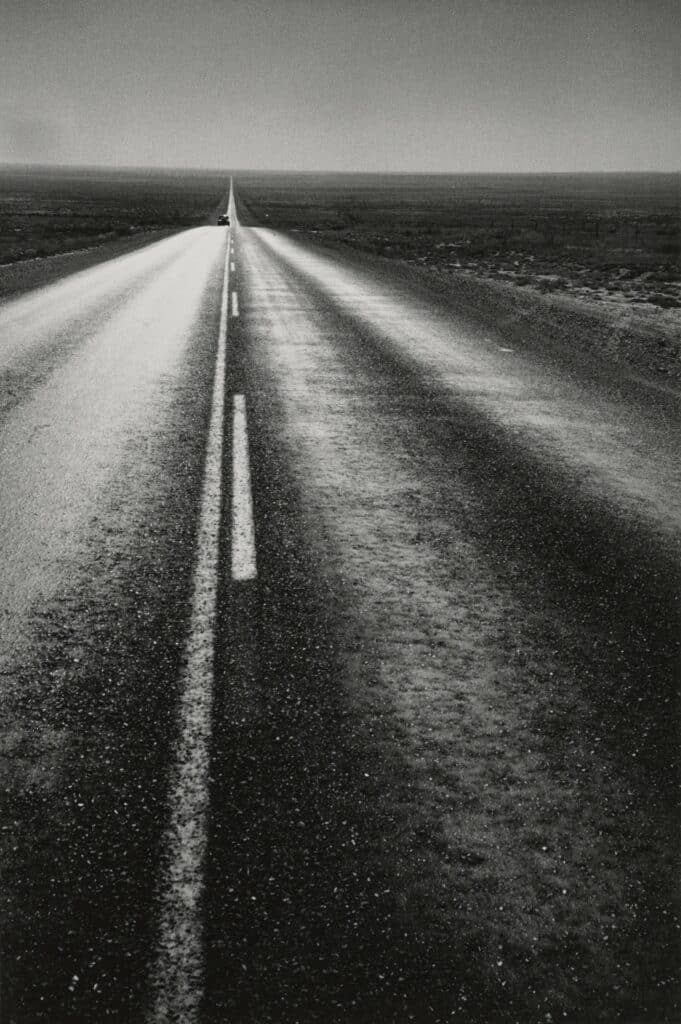
Along a lonely highway
Robert Frank and Todd Webb had plenty in common. For starters, their Guggenheim applications both featured a letter of endorsement from a guy named Walker Evans and, bizarrely, they each requested the exact same amount of funding for their respective trips: $3,600, which would be $41,062.97 in today’s dollars. They’d even crossed paths once a few years before: A 25-year-old Frank popped into a New Year’s Eve party at Webb’s apartment in Paris as 1949 slipped into 1950. Likewise, when you look at the photos from their respective trips, similarities in subject matter abound: flags, cowboys, signs, saloons, parades, people, and the notable absence of landscapes—surprising, as they both passed through some singularly gorgeous terrain.
At first glance, these two spectacular photos of an American highway seem similar, too. But as Volpe points out, a close read reveals subtle yet key differences that shed light on both the photographers’ personalities and their approach. It starts, she says, with the center line: “Where each photographer places you and how the line of the road works in these compositions says so much about how they worked.” Whereas Frank sped from town to town in a used 1950 Ford Business Coupe (which he cheekily nicknamed Luce, a dig at Henry Luce, whose Life magazine promoted America’s white-picket halo), Webb traveled slowly and closer to the ground, walking, biking, using a motorized skiff at one point, and, in the wide-open Southwest, putt-putting along on a Vespa. “With Webb,” says Volpe, “we’re clearly on the side of the road, walking, and the center line slowly curves off into the distance so you feel a greater sense of time and space.”
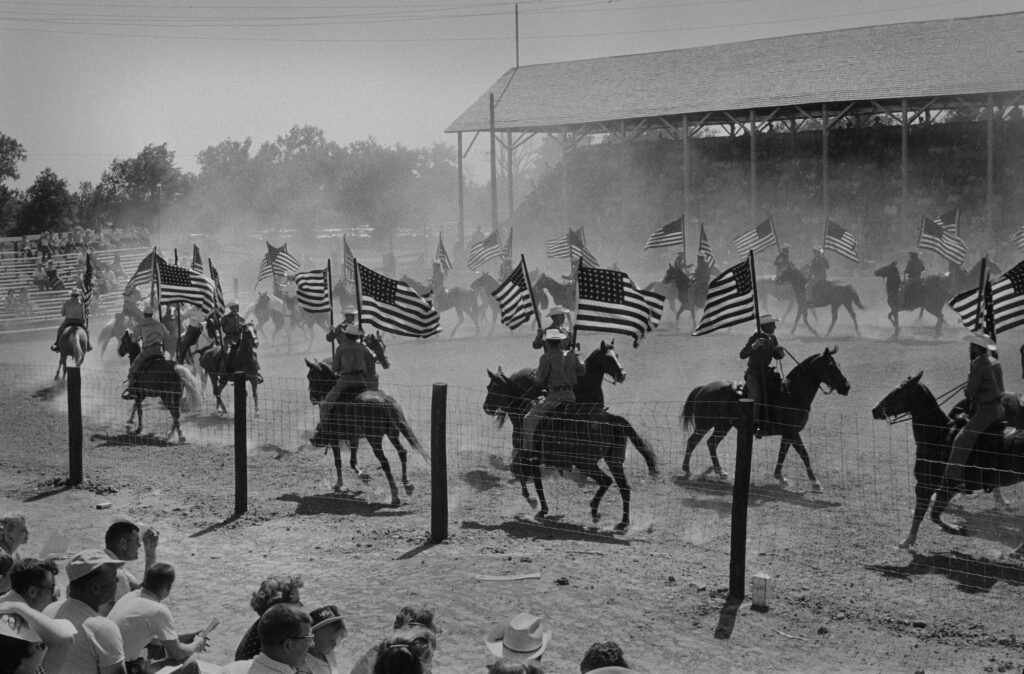
His picture is horizontal and perfectly in focus, a hallmark of more traditional photography. “Frank’s picture,” Volpe says, “is this very dramatic, rapid, literally in-the-middle-of-the-road kind of shot. A little blur, a little grain, all of those things that we come to appreciate about his style.” Frank’s center line is straight, she says, which conveys speed, and it also gives you a sense of how he’s physically moving through the country. And while Webb puts a car in the middle distance, allowing us a glimpse of humanity, Frank shows us a car—more of a speck, really—way off. “These two images,” she says, “really set the stage for who our main characters are and introduce us to the similarities and differences in what they’re doing.”
At the same time, both pictures feature a glowing silver sun on the highway itself. “For a photo nerd like me,” Volpe says, “the sun on the pavement speaks to a golden age of photography, when you had to know your equipment, capture the image in the correct exposure, and utilize that beautiful paper. It’s quintessential of that moment in photography. And I love that they both really went for it.”
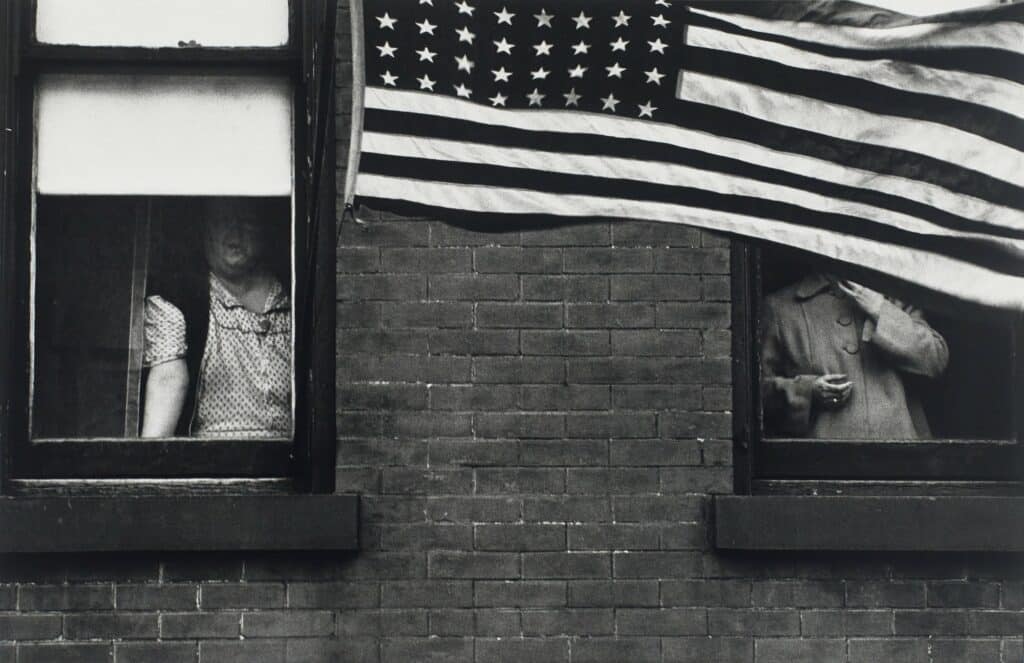
A flag for all seasons
Frank embarked on his road trip with the idea of showing how America’s ambitions would influence the global future, while Webb was chasing the notion of how the country’s past successes played into the present. But after many months and miles, both photographers found themselves disillusioned by what they saw—which is reflected, sometimes starkly, as their work evolves.
Webb, who came to photography relatively late in life (after an unlikely string of jobs: as a stockbroker, forest ranger, and gold prospector), had an everything-will-turn-out-okay attitude and a faith in the American promise of upward mobility. But seeing his countrymen’s fevered embrace of consumerism—not to mention racism—took the edge off his rah-rah enthusiasm. “[Webb] sees that the activity of consumption, of purchasing, is the primary way Americans exercise their freedoms,” Volpe writes in America and Other Myths, the beautiful and highly readable catalog accompanying the exhibit. Webb talks about the “material prosperity and spiritual poverty” he finds on his travels, and how appalled he was by the “hyper-consumerism that pitted neighbor against neighbor” in a battle of suburban one-upmanship.
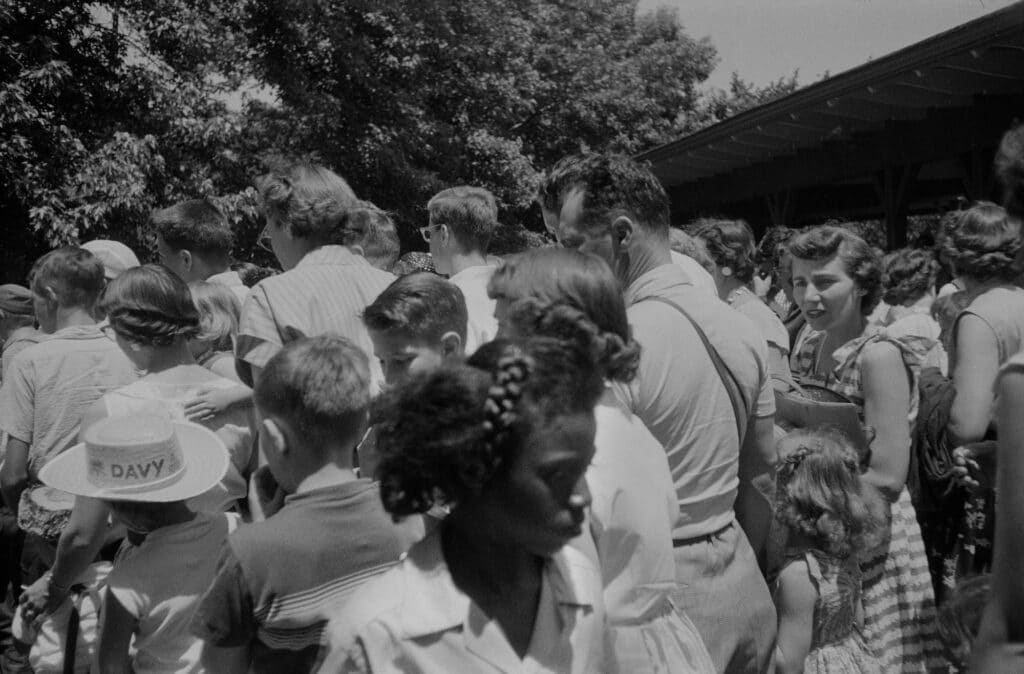
For his part, Frank was arrested at least three times for the crime, essentially, of looking Jewish. (The official police report of one such incident notes that Frank was “shabbily dressed, needed a shave and a haircut … [and] talked with a foreign accent.”) Volpe told me, “A lot of people have spoken about how these arrests make Frank more sensitive to the common man. But I also think it sharpens his eye and his critique in terms of who he’s mad at and everything that the common man has to endure.”
As the myth of American Exceptionalism began to sag under their observant eyes, Frank and Webb used the iconography of the American flag to make pointed critiques. Webb’s picture of the flag-happy rodeo, Volpe says, is typical of the sweet way he offers commentary: using gentle humor. Standing with the crowd, Webb shows us how ridiculous it is to be flying 30 American flags. Says Volpe, “It’s as if Webb is asking, ‘Really? Do you need all of those flags?’ You could compare his sentiment to Warhol’s: the more repetition, the less meaning something holds.”
Frank’s critique—one of the photographer’s truly iconic images—pulls no punches, with the faceless subjects separated from each other by a brick wall. It carries the same sort of brooding alienation present in his famous Trolley image that graces the cover of The Americans first U.S. edition. (Bruce Davidson insightfully said of the book, “It was an America we refused to look at.”) Here, the people in the windows are obscured by both shadows and the stars and stripes. “Frank sharpened his critique along with his compassion,” Volpe writes in the catalog. “His sympathies were for the everyday ‘people on the street’; his bitterness was directed toward the sociopolitical forces of repression that had often pushed them to and kept them at the margins of society.”
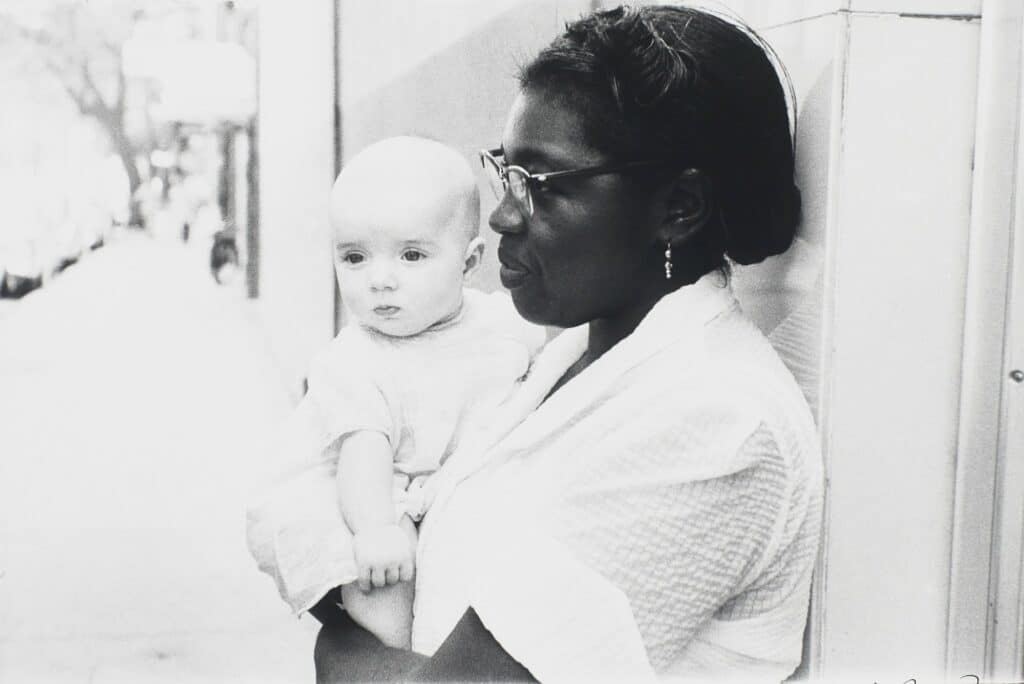
America’s race problem
“Both Frank and Webb were shocked by the racism they encountered,” Volpe told me. “Frank said he had never seen segregation in action before he went to the South, and he produced a lot of photographs that just punch you in the gut.” Webb, who had dated a Black woman before he met his wife, was also disgusted. With his bright-side outlook, Webb’s pictures were typically bighearted and tender, so on the (very) few occasions when he deviated from that, there was a reason.
Such was the case when he visited a zoo in St. Louis and watched as white visitors reacted to a group of Black schoolchildren. “This picture is about racism, about division,” Volpe explains. “This is about the white crowd moving one way while the Black girl is forced to go in the other direction.” Volpe, pointing to the white mother clutching her daughter, says, “Webb wanted to expose those things—he’s trying to combat this idea of alienation—but he never does it as blatantly as Frank does.” While Webb is more gentle in his critique, she says, “It’s the same kind of horror at alienation and having to go against the flow of society.”
Frank’s photo, Charleston, South Carolina, points to the extreme hypocrisy of race relations in the South, where Black people were shoved to the side, held back, stepped on … but somehow trusted enough to care for white children. As for the picture’s power, Volpe points to the infant’s “unsettling, precocious glare” and the caregiver’s forced, fake smile.
Larger than life
What’s most sacred to Americans? What’s important and holy and larger than life? Here, Frank and Webb look to answer these questions. “This is one of those moments,” says Volpe, “where the photographers show us how similar they are.” Frank’s picture, which gives us a statue (Frank actually mislabeled it as St. Francis) seemingly blessing a gas station, was made in—where else?—Los Angeles, the city that came to define car culture. “I’ve always found this photo hilarious,” Volpe says. “It’s a comment on what we value. Instead of pilgrims or people, he’s looking over all of these cars.”
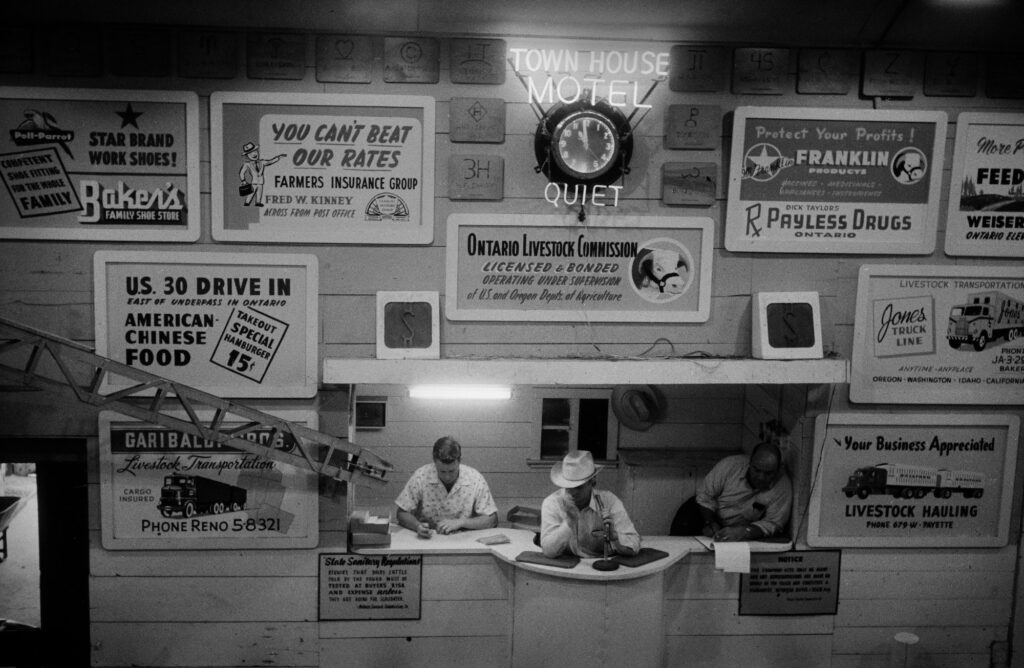
Of course, there’s an ominous tinge to the picture with “St. Francis” all dark and the sky looking rather apocalyptic. Webb’s picture, made in Booneville Salt Flats, Utah, pokes at the very American idea of “the West” and what it symbolizes. The cartoonish cowboy, a stand-in for the concept of the West and the freedom that supposedly goes along with it, dwarfs the cars, the men, and the Chevron holding tank on the hill. Both the cowboy (with his bandana, cigarette, and six-shooter) and “St. Francis” (with his bible, cross, and robes) are selling us something, trying to convince us of something—which Volpe’s curatorial genius brings to the fore. “What I wanted to do as a curator,” she told me, “was not only discover Webb, but rediscover Frank in new ways. And putting them together like this definitely led me to see Frank’s picture in a revealing light.”
Signs of the times
Todd Webb never cared much about money—and never had much. So he was sparing with his film; he’d slowly examine his subject and then carefully make a frame, maybe two. Frank, on the other hand, became famous for his shoot-first-ask-questions-later style. Compared to the 30-year-old Frank, who tore around the country in his Ford, dashing in and out of bars and restaurants to make dynamic pictures full of tension and, as Volpe puts it, “restless energy,” Webb, at 50, was a study in slow-motion precision.
But it’s fair to say that both were obsessed with signs. Perhaps this was because they were both fans of Walker Evans, but perhaps it was because they were both hyper tuned-in to—and horrified by—the mushrooming American consumerism where suddenly everything was for sale all the time. As Volpe told me, both photographers saw Americans “rushing through this repetitive action of consuming, while also focused on these signs that reminded them of all the things they could be consuming and doing and spending their money on.”
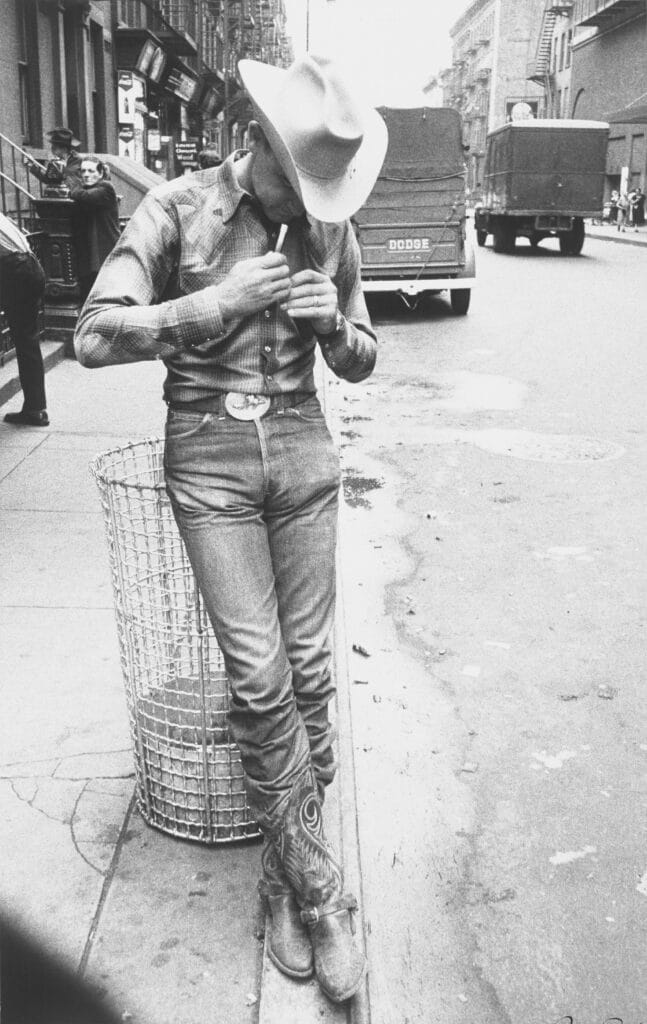
And while the message was the same, their styles were dramatically, radically different. Webb’s well-balanced, classically composed Town House Motel, Ontario, Oregon is jammed with signs but manages to be pin-drop quiet; the three men slumping at the desk appear to be near sleep, and even the neon sign smack in the middle of the frame says Quiet. The picture is formal, clean, precise. In Frank’s more chaotic Detroit Drugstore, on the other hand, you can almost hear the clatter of plates and splink-splank of silverware hitting the counter. “You get that odd angle, and the foreground is interrupted by the cake and a person’s hand in the bottom corner,” Volpe says. “I don’t think Webb could bring himself to make a composition like that. It’s just not his nature.”
With this pairing, Volpe not only demonstrates Frank and Webb’s contrasting approaches but she also nudges us to think about the evolution of photography itself, with the traditional composition making way for a new approach to capturing moments, one in which focus, grain, framing, and contrast are suddenly in play, one that sometimes required more from the viewer to grok what the picture was “about.”
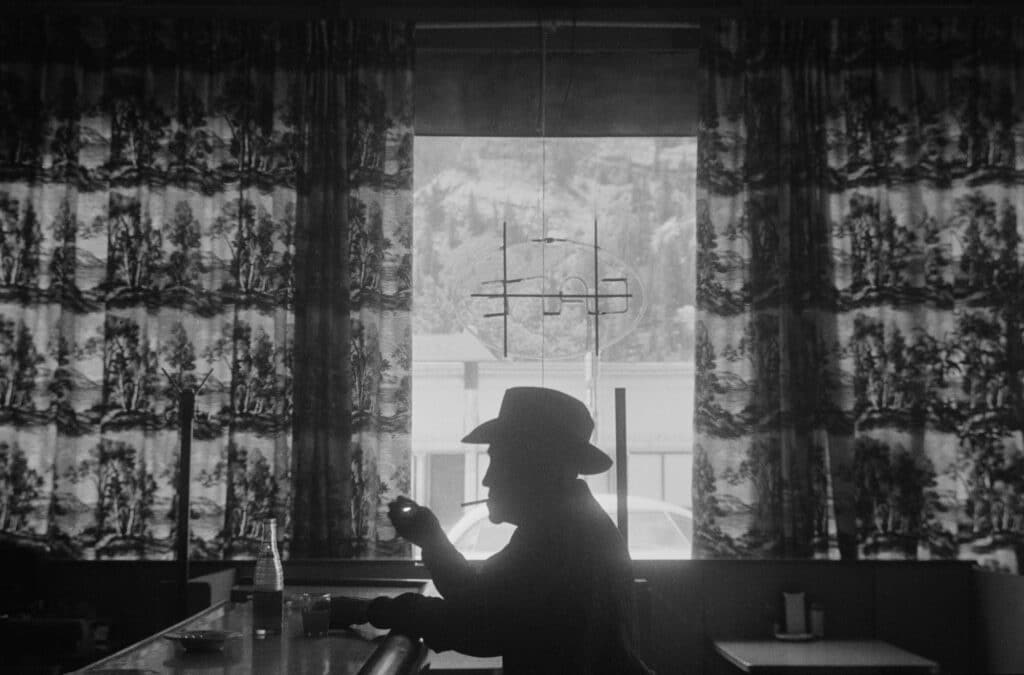
Alone on the range
There may be no more resonant symbol of America than the cowboy, which is likely why Frank and Webb went to great lengths to capture them on film. Frank’s straight-from-central-casting cowboy—cattleman’s hat, denim pants, big ole belt buckle, boots—seemingly air-dropped into Manhattan’s crosstown streets feels out of place, wildly anachronistic, and quite alone, as if the guy’s horse hung a right turn at Montana in 1918 and just kept going. And yet, as he leans against a garbage can and casually lights his hand-rolled smoke, he seems to feel right at home. “What’s really interesting,” Volpe says, “is that Frank made this photo before he knew he’d gotten the Guggenheim. To me, that says that he’s doing this no matter what. He’d already left on his trip before he knew he had funding, which screams that this is an artist who can’t help but make art.”
The image itself is quintessential Frank: “It’s taken at such a dramatic angle, which happens so often in his photos,” she says. But of course there’s something else that we see in countless other photos from Frank’s trip: “You just get that sense of loneliness, like the cowboy doesn’t belong, like why is he in the middle of the city?” Another strange aspect is that something is blocking the lens in the bottom left corner of the frame.
Webb’s cowboy, on the other hand, is positioned impeccably in his surroundings, head framed by the window, hat framed by the neon sign. (Volpe also points to the fact that the tabletop on the right is nicely aligned with the bottom of the frame.) And yet, that same sense of loneliness pervades the image.
When Volpe looks at Webb’s photo (“One of my favorites!” she says) with “all the stillness we associate with Webb” but also the “instantaneousness” of the cowboy’s hand poised to light his cigarette, she sees something else: “It shows that these photographers had the ability and the capacity to change styles if they wanted to, so it’s really their personality that drives their approach.”
Why would these two photographers with such different backgrounds and styles both focus on the loneliness of the cowboy? Perhaps they sensed that something elemental about America was changing, and this uniquely American character—and the character of the country—was being left behind.
Aftermath of a roadtrip
Upon returning from his long and winding cross-country road trip, Frank’s images of America received a frosty reception. Webb’s work fared somewhat better: call it lukewarm. Webb had hoped to make a book, but he didn’t have the push-push-push personality to make it happen and he moved on to other projects. The Americans, deemed too sloppy and cynical, was rejected countless times and couldn’t find an American publisher; it was first published in France. Eventually, of course, The Americans would go on to become perhaps the single most influential photography book of all time, selling an estimated quarter-million copies.
The journal entry Webb wrote upon his return—the journal itself clocks in at a staggering 3,033 pages—shows a deeper understanding of himself and how he stands apart from the cult of consumerism he saw on his travels. “He basically says, ‘I don’t really care about owning things. That’s not who I am,’” says Volpe. What becomes more important to Webb is experiences, and he starts prioritizing them, setting off on another cross-country trip and then scoring a United Nations job that sends him to eight countries in Africa, where he makes a series of extraordinary color pictures. But Webb’s laissez-faire attitude toward money and possessions would, unfortunately, bite him: In the ’70s, he sold his negatives to an unscrupulous art dealer who not only never paid him but scattered the collection; Webb’s brilliant Guggenheim work and the glorious pictures he made in Africa ended up in an Oakland, California, basement, unseen for decades. When the art world was discovering photography in the ’70s and ’80s, Webb’s work was essentially invisible.
And Frank? “He shifts his career following the trip but not in the way that people think—like, he makes The Americans, then immediately drops his camera and never looks back,” Volpe says. What actually happens, she explains, is that he creates an intriguing series called From the Bus, in which he shoots out the window of a bus moving through New York City. “But he really does come back from this journey thinking more about filmmaking,” she says, “because he feels there’s nowhere to hide when you’re making a film. You can’t edit out entire portions in the same way that you edit, entire rolls of film out. He wants to keep pushing himself as an artist, keep challenging himself at every turn.”
Setting cowboys and uncrowded highways aside, Volpe says, in some ways, the America of 1955 is not so different from America in 2023, with its contradictions, conflicts, and inconsistencies that we’re still living with today. The issues have changed—no one was arguing over gun rights, abortion rights, vaccinations, and pronouns in the ’50s—but Volpe says that both Frank and Webb were most definitely exploring the concept of personal freedoms. Webb, she says, “might ask, ‘Why are you defining your freedoms by how much stuff you buy?’” And Frank, she believes, “would argue that, sure, everyone has personal freedoms, but those freedoms, and the limits of those freedoms, are determined by how much social and economic power you have.” In the end, she says, “Americanness is endlessly weird and contradictory,” a notion Robert Frank and Todd Webb not only captured, but helped us understand.
“Robert Frank and Todd Webb: Across America, 1955” opens at the Museum of Fine Arts, Houston, on October 8 and runs until January 7, 2024.

